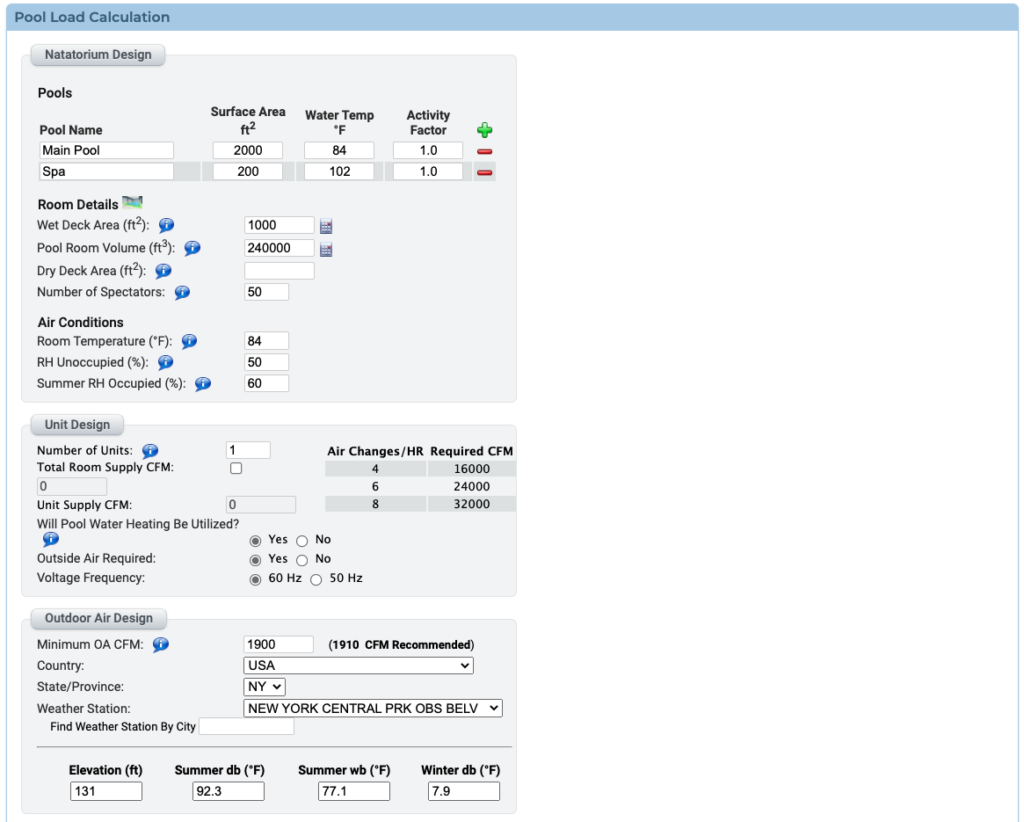Everything Engineers, Contractors, and Owners Need to Know to Create the Optimal Indoor Pool Environment.
CHAPTER THREE
While warm space temperatures and 50-60% relative humidity levels are ideal for patron comfort, they also translate to high dew point conditions which can lead to condensation problems and serious damage to the building structure (in cool/cold weather). If the building structure itself has not been properly designed for this higher indoor dew point application, catastrophic results may occur. The architect should design and protect the building envelope based on an indoor dew point design condition.
Controlling humidity to provide this stable dew point condition year round requires that a total moisture load be accurately calculated. This moisture load must be removed from the space at the same rate it is generated in order to maintain stable space conditions.
It is imperative that the designer know what the operating temperatures will be in order to properly establish loads.
SEASONAL LOAD CALCULATION
Every building’s moisture (latent) load is calculated the same way. There are generally three sources of moisture that are considered:
- Internal load (pool evaporation)
- Occupants
- Outdoor air load
In the summer, the outdoor air tends to be a load, but since it is warm outside, condensation is not a concern, so it is recommended to model the space at 60% RH.
In the winter, there is significant risk of condensation, so it is recommended to model at 50% RH. The outdoor air in winter almost always is a dehumidification credit, making this easily achievable.
POOL EVAPORATION
The internal load in a natatorium is the evaporation from the pool water and continuously wet surfaces. In a natatorium, this represents the majority of the total dehumidification load. Consequently, it is essential to accurately predict the pool evaporation.
There are five variables used to calculate the evaporation rate:
- Pool water surface area
- Pool water temperature
- Room air temperature
- Room air relative humidity
- Pool water agitation and activity factor
The first four variables are straightforward and should be dictated by the owner. They are used to calculate the baseline (unoccupied) evaporation rate in the natatorium.
The activity factor is the fifth variable. It is used to evaluate how much water agitation and splashing is expected when the pool is in use and how that increases the evaporation from the baseline value. Chapter 6 of ASHRAE’s HVAC Applications Handbook publishes an activity factor table (Table 2) based on years of empirical field and test data.
TABLE 2 – ACTIVITY FACTORS
| TYPE OF POOL | ACTIVITY FACTOR |
|---|---|
| Elderly Swim | 0.65 |
| Fitness Club — Aquafit | 0.65 |
| Hotel | 0.8 |
| Institutional — School | 0.8 – 1.0 |
| Physical Therapy | 0.65 |
| Public/YMCA | 1.0 |
| Residential | 0.5 |
| Swim Meet | 1.0 |
| Wave Pool | 1.5 – 2.0 |
| Whirlpool | 1.0 |
(FLATWATER) EVAPORATION RATE EQUATION
Equation #2 in chapter 6 of ASHRAE’s 2019 HVAC Applications Handbook calculates the evaporation rate in pounds of water per hour (lb/h) for air velocity over water at 10-30 fpm. The vapor pressure values can be found in steam tables.
ER = 0.1 x A x AF (Pw – Pdp)
where
ER = evaporation rate of water, lb/h
A = area of pool water surface, ft2
AF = activity factor (Table 2)
Pw = saturation vapor pressure at water surface, in. Hg
Pdp = partial vapor pressure at room dew point, in. Hg
As evident by the equation, the following factors increase the evaporation rate:
- Increasing water temperature
- Lowering air temperature
- Lowering air relative humidity
- High activity/agitation
Once equipment has been selected and installed, any change of the variables that increases the evaporation rate can result in equipment no longer being suitable for the new larger load.
WATER FEATURES AND TOYS
It is important to understand that the entire effective water surface area and relative velocity (air and/or water) is required to estimate evaporation.
Manufacturers of water features and toys do not publish the evaporation loads from their products, forcing engineers to estimate. As a result, any indoor space heavily laden with water toys will make it difficult to accurately model dehumidification loads, so it is important for designers to set expectations with the owner. For example, there should not be an expectation that exact relative humidity levels will be maintained.
OCCUPANT LOAD
Swimmers are not usually considered occupants as they are submerged in the water. Swimmers and their water agitation are included in the activity factor. Spectators, especially in facilities that host large swim meets, can total several thousand – and add a significant moisture load (Table 3).
TABLE 3 – OCCUPANTS’ LATENT LOAD
| ACTIVITY LEVEL | LB/H PER SPECTATOR |
|---|---|
| Quietly Seated | 0.155 |
| Moderate Activity | 0.205 |
| Enthusiastic | 0.250 |
| Highly Enthusiastic | 0.530 |
SWIM MEETS
Facilities that host swim meets have two distinct modes of operation: normal daily use and swim meets.
To evaluate the peak dehumidification load during swim meets (which occurs during the warm-ups), an activity factor of 1.0 should be used. The total number of spectators and competitors on the pool deck must also be included in the load. Codes also generally require that each spectator be provided with 7.5 CFM of outdoor air. The load impact of the outdoor air must also be calculated.
Facilities should size equipment based on the larger of the two main operating modes.
SPECTATOR GALLERIES
If there is a dedicated spectator gallery of a suitable size, there could be an opportunity to create a separate microclimate for them during swim meets using a dedicated spectator HVAC unit. A dedicated HVAC unit can deliver the extra outdoor air needed to this area during the meet while also providing a slightly different (usually cooler) space condition that is more comfortable for the spectators.
OUTDOOR AIR
The introduction of outdoor air is essential to maintaining good air quality in any facility. The impact of this outdoor air ventilation on a natatorium changes with the weather and the geographic location of the facility. Introducing outdoor air during the summer generally adds moisture to the space, and in the winter, removes moisture from the space. For maximum dehumidification load calculations, the summer design conditions are considered.
Construction codes generally require that outdoor air be introduced into a commercial building during occupied hours. ASHRAE Standard 62 Table 6.1 recommends the introduction of outdoor air into a natatorium at the following rates:
- 0.48 CFM/ft2 of pool water and wet deck area
- Some versions of Table 6.1 call for 0.06 CFM/ft2 dry deck as base line
- 7.5 CFM per spectator added to the base line during swim meets
The purpose of this outdoor air, in part, is to help dilute chemicals off-gassed from water. Exceeding code requirements for outdoor air will not necessarily provide better air quality. In winter, it will significantly increase the operating expenses, and in summer, may increase the dehumidification load.
LOAD ESTIMATION SOFTWARE
There is software based on ASHRAE criteria that calculates all moisture loads in a matter of minutes. Figure 2 provides a snapshot of the basic data that would generally need to be entered to calculate a load.


